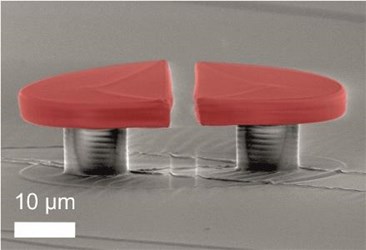Split-Disk Whispering Gallery Mode Resonators For Tuning Micro-Lasers
By Jof Enriquez,
Follow me on Twitter @jofenriq

Scientists at the Institute of Applied Physics, Karlsruhe Institute of Technology, Germany, have designed a split-disk whispering gallery mode (WGM) resonator that controls the tunability of lasers by stretching a flexible substrate.
A WGM resonator utilizes the concept of a cathedral's whispering gallery, which amplifies sounds as faint as a whisper and carries it across to the other side of the building, as sound waves travel around the curved surface of the cathedral's dome.
In the same manner, light waves propagate and bounce many times around a ring-shaped or spherical microresonator waveguide, and the superimposed waves can produce lasers. Typically, tuning the resultant laser is done mainly through the modification of the refractive index of the microresonator.
Another way to control the resonance frequency is by altering the resonator design. Many researchers are testing various configurations to modify the shape or structure of optical resonators to achieve resonance tuning and improve sensitivity.
The German team's approach is by making a microresonator with a disk (25-microns in diameter) that is split in the middle by an air gap of 2.5 microns. The opposing half-disks are mounted onto an elastomeric substrate, which can be mechanically stretched to change the distance between the split disks, and thus, the wavelength of the light produced.
Using this technique, the researchers report being able to tune laser modes by more than three times the free spectral range.
“Our new design produces a broad tuning range that cannot be easily achieved with other WGM resonators,” said Tobias Siegle, lead author of the study published in APL Photonics. “Additionally, the tuning mechanism is completely reversible.”
Moreover, compared to microresonators without a gap, theirs demonstrated a marked improvement in refractive index sensing.
“For a gap width of 1.4 microns, the sensing performance is increased by 65 percent,” said Siegle.
They sought to build a WGM microresonator with a high Q (quality) factor (which refers to the photon storage time in the laser cavity). But even though enlarging the gap between the disks resulted in a lower Q factor, a low lasing threshold was maintained during testing. A low lasing threshold is considered ideal in prolonging the life of the device.
The team said their unique split-disk WGM microresonator design could "form a key element of flexible and tunable photonic circuits based on polymers."
